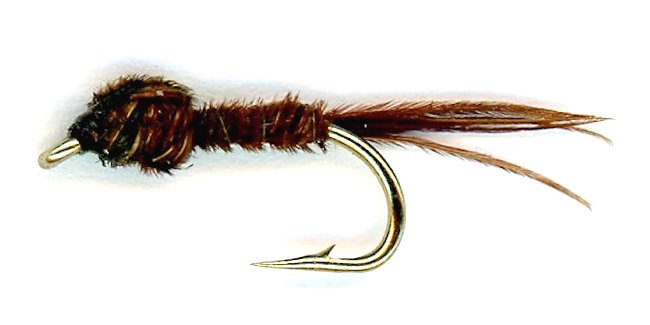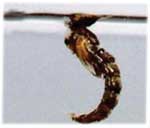The Natural Pheasant Tail Nymph Fly
The Pheasant Tail is, without doubt, the best may fly nymph imitation ever designed. For example just have a look at a photograph of a Blue Winged Olive nymph and you will see that it is a wonderful match for it's shape and color.

PHEASANT TAIL FLY PATTERNS. Hook size 12 14 16 18 - $US each
The English Fly Fishing Shop's version of the traditional Pheasant Tail Nymph has flash on the top of their body but not the wing case. From experience we have found that the addition of the flash helps catch the eye of passing trout. These flies out fish Pheasant Tail Nymphs without the flash. Another fly we stock called the Flashback Pheasant Tail Nymph has flash on top of the whole length of the nymph including the wing case.
The Natural Pheasant Tail Nymph fly pattern is designed to sink fast when presented up stream to a subsurface feeding trout. It works effectively in the moving water of streams and the still water of lakes. It is one of the five most popular trout flies used. Different types of may flies appear all year long, and the nymph stage is the easiest one for trout to find consistently. May fly's nymphs are versatile as they can live in fast, turbulent water, or in slow or still water environments. By shuffling the gravel on a stream or lake, and looking on stream bed rocks, you'll find the nymphs and it's a simple matter of matching the fly size to get a convincing match. The may fly nymph on a stream river or lake bed will try to hide and can be difficult of fish to find unlike the mature nymphs that rise to the surface to emerge into the adult dun may fly. We have added a small bit of flash on the back to help trout and steelhead fish detect the nymph. The flash helps catch the eye of passing trout. The aim is to suggest the sparkle seen in the water caused by the gases trapped within the skin of a mature rising nymph as it prepares to hatch into a mayfly dun.
If you see trout darting from side to side under the water they are grabbing rising mature may fly nymphs as they are swept past on the current. You do not need a heavily weighted artificial fly to imitate these ascending nymphs. With it's streamlined shape the pheasant tail nymph penetrates the water surface instantly and sinks quickly. If lifted gently in front of or beside a fish to simulate the upward movement of the real natural insect rising to the surface you can induce a 'take'. To document the effectiveness of this pattern, Gary Borger, in his book Nymphs, noted that in 1973 he received Frank Sawyer's book for his birthday and from it tied some Pheasant Tail nymphs for use on a Montana spring creek. In his first experience with this fly, he caught 27 fish in 100 feet of stream in 2 hours, all between 1 and 3.5 pounds. While I make no promises, this anecdote illustrates why you need to add this fly to your nymph selection, if you have not already done so. It's a good idea to carry a good size assortment of Pheasant Tail Nymphs.

In the early part of the 1900’s using subsurface nymph flies was scorned as unsportsman like by the dry fly only devotees. That changed when forward looking anglers like G.E.M. Skues pioneered the use of artificial nymphs like the Pheasant Tail Nymph. Not only were they effective at catching trout but he showed that skill was required in how you fished the nymph fly patterns but also in how you tied the underwater flies to match the natural insects. He showed that the two approaches to fly fishing for trout and grayling were very similar. Both would give hours of enjoyment and their fair amount of fishing challenges.
Other fly fishing angler soon gained notoriety promoting the effectiveness of fishing with nymph flies; fishermen like Frank Sawyer, Oliver Kite, Arthur Cove and many others. In natural fresh water systems, lakes, rivers and streams, as well as manmade large reservoirs and canals, most of the food fish survive on is found under the water surface. Most aquatic insects spend the vast majority of their life span under the water. They spend months or years under the water foraging for food to grow the correct size that will enable them to hatch into an adult. Most are available as a food source to trout and grayling thought out this time. The fly fishing angler has only one day in the year to imitate this insect as it is emerging. Contrary to popular belief adult flies, whether just hatched duns or spent spinners floating in the surface film, only form a tiny part of a fish’s annual food intake.
So what fly rod should you use for nymph fishing? Rods above a 6/7 rating have a powerful action and do not give enough when playing trout on small hooks. There is a tendency for the hook to be torn out when a trout lunges or makes a run, especially at short range. I would recommend a rod length of 9 foot for smaller stillwaters and 10 foot to 10 ½ foot for large waters is about right. For small rivers 7 ½ foot to 8 ½ foot length fishing rods should be adequate.
DEEP WATER BOAT FISHING
Chris Reeves is a local guide and active competition fly fisherman. His favorite match fishing deep water boat fishing technique involves having a very long leader the same length as the depth of the water. He ties on four buzzers. Pheasant Tail nymphs or soft hackled 'Spider' wet flies. the trick is to make a long cast down stream, then wait until the boat has floated directly on top of the flies. The flies have had time to sink to the bottom. he then begins the retrieve. The flies move up to the surface vertically mimicking the natural emerging insects as they make their way up to the surface. He keeps his rod tip near the surface above them and makes a stop start gentle retrieve with no slack line. When the fish take they are slightly disorientated at first and move up towards the boat but then hang on as they realize what has happened and try to swim off.
CUSTOMER'S COMMENT
Pheasant Tail Nymphs in size 16, 14 & 12 are in my top ten list of flies. Most of my fishing is on rivers and streams in Maine, USA. Occasionally I'll canoe a few ponds. Most noted are the rivers of Kennebec, Penobscot, Moose, Crooked, Rapid, Messalonskee, Kenebago, Grand Lake Stream, Magaloway, Dead River, Kenduskeag and Sebasticook. As always tight lines, Jeff Haresear
CUSTOMER'S COMMENT
I have had the Pheasant Tail Nymph take countless trout in the 2-6lb range in Iceland. Adrian Latimer, France


Fly Fishing books

